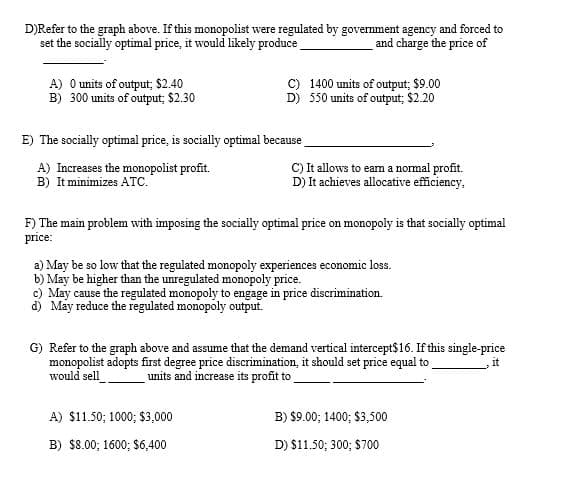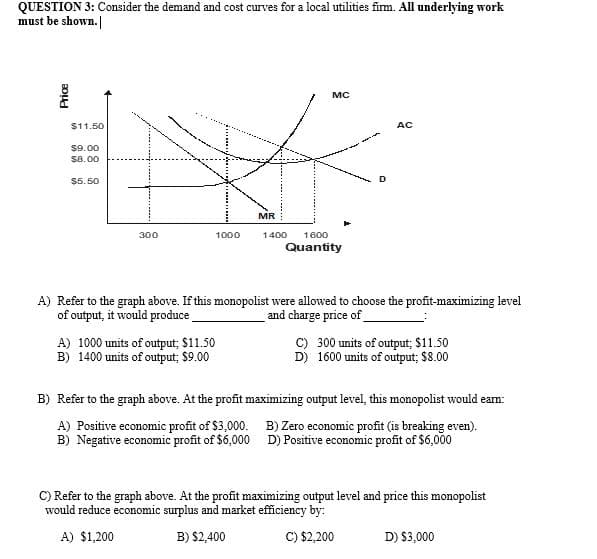D)Refer to the graph above. If this monopolist were regulated by govemment agency and forced to set the socially optimal price, it would likely produce and charge the price of A) O units of output; $2.40 B) 300 units of output; $2.30 C) 1400 units of output; $9.00 D) 550 units of output; $2.20 E) The socially optimal price, is socially optimal because A) Increases the monopolist profit. B) It minimizes ATC. C) It allows to eam a normal profit. D) It achieves allocative efficiency, F) The main problem with imposing the socially optimal price on monopoly is that socially optimal price: a) May be so low that the regulated monopoly experiences economic loss. b) May be higher than the unregulated monopoly price. c) May cause the regulated monopoly to engage in price discrimination. d) May reduce the regulated monopoly output.
D)Refer to the graph above. If this monopolist were regulated by govemment agency and forced to set the socially optimal price, it would likely produce and charge the price of A) O units of output; $2.40 B) 300 units of output; $2.30 C) 1400 units of output; $9.00 D) 550 units of output; $2.20 E) The socially optimal price, is socially optimal because A) Increases the monopolist profit. B) It minimizes ATC. C) It allows to eam a normal profit. D) It achieves allocative efficiency, F) The main problem with imposing the socially optimal price on monopoly is that socially optimal price: a) May be so low that the regulated monopoly experiences economic loss. b) May be higher than the unregulated monopoly price. c) May cause the regulated monopoly to engage in price discrimination. d) May reduce the regulated monopoly output.
Managerial Economics: Applications, Strategies and Tactics (MindTap Course List)
14th Edition
ISBN:9781305506381
Author:James R. McGuigan, R. Charles Moyer, Frederick H.deB. Harris
Publisher:James R. McGuigan, R. Charles Moyer, Frederick H.deB. Harris
Chapter16: Government Regulation
Section: Chapter Questions
Problem 10E
Related questions
Question
part D E F G

Transcribed Image Text:D)Refer to the graph above. If this monopolist were regulated by govemment agency and forced to
set the socially optimal price, it would likely produce
and charge the price of
A) O units of output; $2.40
B) 300 units of output; $2.30
1400 units of output; $9.00
D) 550 units of output; $2.20
E) The socially optimal price, is socially optimal because
A) Increases the monopolist profit.
B) It minimizes ATc."
C) It allows to eam a normal profit.
D) It achieves allocative efficiency,
F) The main problem with imposing the socially optimal price on monopoly is that socially optimal
price:
a) May be so low that the regulated monopoly experiences economic loss.
b) May be higher than the unregulated monopoly price.
c) May cause the regulated monopoly to engage in price discrimination.
d) May reduce the regulated monopoly output.
G) Refer to the graph above and assume that the demand vertical intercept$16. If this single-price
monopolist adopts first degree price discrimination, it should set price equal to
units and increase its profit to
would sell
A) $11.50; 1000; $3,000
B) $9.00; 1400; $3,500
B) $8.00; 1600; $6,400
D) $11.50; 300; $700

Transcribed Image Text:QUESTION 3: Consider the demand and cost curves for a local utilities firm. All underlying work
must be shown.
MC
$11.50
AC
$9.00
$8.00
$5. 50
MR
300
1000
1400
1600
Quantity
A) Refer to the graph above. If this monopolist were allowed to choose the profit-maximizing level
of output, it would produce
and charge price of
A) 1000 units of output; $11.50
B) 1400 units of output; $9.00
C) 300 units of output; $11.50
D) 1600 units of output; $8.00
B) Refer to the graph above. At the profit maximizing output level, this monopolist would eam:
A) Positive economic profit of $3,000. B) Zero economic profit (is breaking even).
B) Negative economic profit of $6,000 D) Positive economic profit of $6,000
C) Refer to the graph above. At the profit maximizing output level and price this monopolist
would reduce economic surplus and market efficiency by:
A) $1,200
B) $2,400
C) $2,200
D) $3,000
Expert Solution
This question has been solved!
Explore an expertly crafted, step-by-step solution for a thorough understanding of key concepts.
This is a popular solution!
Trending now
This is a popular solution!
Step by step
Solved in 3 steps

Knowledge Booster
Learn more about
Need a deep-dive on the concept behind this application? Look no further. Learn more about this topic, economics and related others by exploring similar questions and additional content below.Recommended textbooks for you

Managerial Economics: Applications, Strategies an…
Economics
ISBN:
9781305506381
Author:
James R. McGuigan, R. Charles Moyer, Frederick H.deB. Harris
Publisher:
Cengage Learning



Managerial Economics: Applications, Strategies an…
Economics
ISBN:
9781305506381
Author:
James R. McGuigan, R. Charles Moyer, Frederick H.deB. Harris
Publisher:
Cengage Learning

